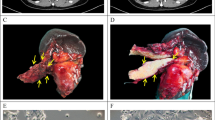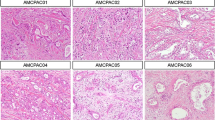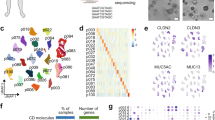Abstract
There are a large number of stable pancreatic ductal carcinoma cell lines (PDCL) that are used by researchers worldwide. Detailed data about their differentiation status and genetic alterations are present in the literature, but a systematic correlation with cell biological behavior is often lacking. PDCL (n=12) were clustered by source of tumor cell (ascites, primary tumor, metastasis), and the data of functional cell biology were correlated with the reported structural and genetic profiles. Major histocompatibility complex expression, chemosensitivity and aneuploidia appeared to be related to the source of PDCL, and proliferative capacity appeared to be related to the grade of differentiation. No correlation between genetic/structural features of PDCL and biological behavior was found. All the cell lines appeared generally insensitive to in vitro treatment with 5-fluorouracil and showed variable degrees of susceptibility to gemcitabine, raltitrexed and oxaliplatin. All the PDCL showed resistance to Fas-mediated apoptosis but were significantly sensitive to the pro-apoptotic effect of inflammatory cytokines [interleukin (IL)-1β, tumor necrosis factor (TNF)α and interferon γ]. PDCL were characterized for the secretion of several factors relevant to the tumor-immune cross talk. Vascular endothelial growth factor, CCL2, CCL5 and transforming growth factor β were the factors most frequently released; less frequent was the secretion of CXCL8, CCL22, IL-6 and sporadically CXCL12, IL-10 and hepatocyte growth factor. The cytokines IL-1β and TNFα were always undetectable. In conclusion, a clear correlation between structural/genetic features and function could not be detected, suggesting the weakness of a “morphological” classification for the in vitro studies of pancreatic cancer.



Similar content being viewed by others
References
Parker SL, Tong T, Bolden S, Wingo PA (1997) Cancer statistics. CA Cancer J Clin 47:5–27
Wanebo HJ, Vezeridis MP (1996) Pancreatic carcinoma in perspective. A continuing challenge. Cancer 78[Suppl]:580–591
Hawes RH, Xiong Q, Waxman I, Chang KJ, Evans DB, Abbruzzese JL (2000) A multispecialty approach to the diagnosis and management of pancreatic cancer. Am J Gastroenterol 95:17–31
Wolff RA, Chiao P, Lenzi R, Pisters PW, Lee JE, Janjan NA et al (2000) Current approaches and future strategies for pancreatic carcinoma. Invest New Drugs 18:43–56
Abbruzzese JL (2002) New applications of gemcitabine and future directions in the management of pancreatic cancer. Cancer 95[Suppl]:941–945
Bardeesy N, DePinho RA (2002) Pancreatic cancer biology and genetics. Nat Rev Cancer 2:897–909
Ruiz-Cabello F, Garrido F (1998) HLA and cancer: from research to clinical impact. Immunol Today 19:539–542
Pardoll D (2003) Does the immune system see tumors as foreign or self? Annu Rev Immunol 21:807–839
Dunn GP, Bruce AT, Ikeda H, Old LJ, Schreiber RD (2002) Cancer immunoediting: from immunosurveillance to tumor escape. Nat Immunol 3:991–998
Chouaib S, Thiery J, Gati A, Guerra N, El Behi M, Dorothee G et al (2002) Tumor escape from killing: role of killer inhibitory receptors and acquisition of tumor resistance to cell death. Tissue Antigens 60:273–281
Sipos B, Moser S, Kalthoff H, Torok V, Lohr M, Kloppel G (2003) A comprehensive characterization of pancreatic ductal carcinoma cell lines: towards the establishment of an in vitro research platform. Virchows Arch 442:444–452
Moore PS, Sipos B, Orlandini S, Sorio C, Real FX, Lemoine NR et al (2001) Genetic profile of 22 pancreatic carcinoma cell lines. Analysis of K-ras, p53, p16 and DPC4/Smad4. Virchows Arch 439:798–802
Vila MR, Lloreta J, Schussler MH, Berrozpe G, Welt S, Real FX (1995) New pancreas cancers cell lines that represent distinct stages of ductal differentiation. Lab Invest 72:395–404
Ozawa F, Friess H, Tempia-Caliera A, Kleeff J, Buchler MW (2001) Growth factors and their receptors in pancreatic cancer. Teratog Carcinog Mutagen 21:27–44
Shi X, Friess H, Kleeff J, Ozawa F, Buchler MW (2001) Pancreatic cancer: factors regulating tumor development, maintenance and metastasis. Pancreatology 1:517–524
Kloppel G, Lingenthal G, von Bulow M, Kern HF (1985) Histological and fine structural features of pancreatic ductal adenocarcinomas in relation to growth and prognosis: studies in xenografted tumours and clinico-histopathological correlation in a series of 75 cases. Histopathology 9:841–856
Lieber M, Mazzetta J, Nelson-Rees W, Kaplan M, Todaro G (1975) Establishment of a continuous tumor-cell line (panc-1) from a human carcinoma of the exocrine pancreas. Int J Cancer 15:741–747
Yunis AA, Arimura GK, Russin DJ (1977) Human pancreatic carcinoma (MIA PaCa-2) in continuous culture: sensitivity to asparaginase. Int J Cancer 19:218–235
Elsasser HP, Lehr U, Agricola B, Kern HF (1993) Structural analysis of a new highly metastatic cell line PaTu 8902 from a primary human pancreatic adenocarcinoma. Virchows Arch 64:201–207
Drucker BJ, Marincola FM, Siao DY, Donlon TA, Bangs CD, Holder WD Jr (1988) A new human pancreatic carcinoma cell line developed for adoptive immunotherapy studies with lymphokine-activated killer cells in nude mice. In Vitro Cell Dev Biol 24:1179–1187
Fogh J, Wright WC, Loveless JD (1977) Absence of HeLa cell contamination in 169 cell lines derived from human tumors. J Natl Cancer Inst 58:209–214
Kyriazis AP, Kyriazis AA, Scarpelli DG, Fogh J, Rao MS, Lepera R (1982) Human pancreatic adenocarcinoma line Capan-1 in tissue culture and the nude mouse: morphologic, biologic, and biochemical characteristics. Am J Pathol 106:250–260
Berrozpe G, Schaeffer J, Peinado MA, Real FX, Perucho M (1994) Comparative analysis of mutations in the p53 and K-ras genes in pancreatic cancer. Int J Cancer 58:185–191
Kalthoff H, Schmiegel W, Roeder C, Kasche D, Schmidt A, Lauer G et al (1993) p53 and K-RAS alterations in pancreatic epithelial cell lesions. Oncogene 8:289–298
Naumann M, Savitskaia N, Eilert C, Schramm A, Kalthoff H, Schmiegel W (1996) Frequent codeletion of p16/MTS1 and p15/MTS2 and genetic alterations in p16/MTS1 in pancreatic tumors. Gastroenterology 110:1215–1224
Schutte M, Hruban RH, Hedrick L, Cho KR, Nadasdy GM, Weinstein CL et al (1996) DPC4 gene in various tumor types. Cancer Res 56:2527–2530
McIntosh JC, Schoumacher RA, Tiller RE (1988) Pancreatic adenocarcinoma in a patient with cystic fibrosis. Am J Med 85:592
Schoumacher RA, Ram J, Iannuzzi MC, Bradbury NA, Wallace RW, Hon CT et al (1990) A cystic fibrosis pancreatic adenocarcinoma cell line. Proc Natl Acad Sci U S A 87:4012–4016
Owens RB, Smith HS, Nelson-Rees WA, Springer EL (1976) Epithelial cell cultures from normal and cancerous human tissues. J Natl Cancer Inst 56:843–849
Sun C, Yamato T, Furukawa T, Ohnishi Y, Kijima H, Horii A (2001) Characterization of the mutations of the K-ras, p53, p16, and SMAD4 genes in 15 human pancreatic cancer cell lines. Oncol Rep 8:89–92
Fink SP, Mikkola D, Willson JK, Markowitz S (2003) TGF-beta-induced nuclear localization of Smad2 and Smad3 in Smad4 null cancer cell lines. Oncogene 22:1317–1323
Yamaguchi N, Uozumi G, Ikeuchi H, Morioka H, Machino M, Kawai K (1983) Establishment and characterization of a carcinoembryonic antigen producing cell line derived from human pancreatic exocrine cancer. Gastroenterol Jpn 18:585–592
Okabe T, Yamaguchi N, Ohsawa N (1983) Establishment and characterization of a carcinoembryonic antigen (CEA)-producing cell line from a human carcinoma of the exocrine pancreas. Cancer 51:662–668
Hirai H, Okabe T, Anraku Y, Fujisawa M, Urabe A, Takaku F (1985) Activation of the c-K-ras oncogene in a human pancreas carcinoma. Biochem Biophys Res Commun 127:168–174
Tan MH, Shimano T, Chu TM (1981) Differential localization of human pancreas cancer-associated antigen and carcinoembryonic antigen in homologous pancreatic tumoral xenograft. J Natl Cancer Inst 67:563–569
Chen WH, Horoszewicz JS, Leong SS, Shimano T, Penetrante R, Sanders WH et al (1982) Human pancreatic adenocarcinoma: in vitro and in vivo morphology of a new tumor line established from ascites. In Vitro 18:24–34
Metzgar RS, Gaillard MT, Levine SJ, Tuck FL, Bossen EH, Borowitz MJ (1982) Antigens of human pancreatic adenocarcinoma cells defined by murine monoclonal antibodies. Cancer Res 42:601–608
Barton CM, Staddon SL, Hughes CM, Hall PA, O’Sullivan C, Kloppel G et al (1991) Abnormalities of the p53 tumour suppressor gene in human pancreatic cancer. Br J Cancer 64:1076–1082
Peri G, Milanese C, Matteucci C, Ruco L, Zhou D, Sozzani S et al (1994) A new monoclonal antibody (5D3-F7) which recognizes human monocyte-chemotactic protein-1 but not related chemokines. Development of a sandwich ELISA and in situ detection of producing cells. J Immunol Methods 174:249–257
Piemonti L, Monti P, Sironi M, Fraticelli P, Leone BE, Dal Cin E et al (2000) Vitamin D3 affects differentiation, maturation, and function of human monocyte-derived dendritic cells. J Immunol 164:4443–4451
Miller DW, Fontain M, Kolar C, Lawson T (1996) The expression of multidrug resistance-associated protein (MRP) in pancreatic adenocarcinoma cell lines. Cancer Lett 107:301–306
Torres MJ, Ruiz-Cabello F, Skoudy A, Berrozpe G, Jimenez P, Serrano A et al (1996) Loss of an HLA haplotype in pancreas cancer tissue and its corresponding tumor derived cell line. Tissue Antigens 47:372–381
Scupoli MT, Sartoris S, Tosi G, Ennas MG, Nicolis M, Cestari T et al (1996) Expression of MHC class I and class II antigens in pancreatic adenocarcinomas. Tissue Antigens 48:301–311
Pernick NL, Sarkar FH, Tabaczka P, Kotcher G, Frank J, Adsay NV (2002) Fas and Fas ligand expression in pancreatic adenocarcinoma. Pancreas 25:36–41
Kornmann M, Ishiwata T, Kleeff J, Beger HG, Korc M (2000) Fas and Fas-ligand expression in human pancreatic cancer. Ann Surg 231:368–379
Ungefroren H, Voss M, Bernstorff WV, Schmid A, Kremer B, Kalthoff H (1999) Immunological escape mechanisms in pancreatic carcinoma. Ann N Y Acad Sci 880:243–251
Wright P, Braun R, Babiuk L, Littel-van den Hurk SD, Moyana T, Zheng C et al (1999) Adenovirus-mediated TNF-alpha gene transfer induces significant tumor regression in mice. Cancer Biother Radiopharm 14:49–57
Stoelcker B, Ruhland B, Hehlgans T, Bluethmann H, Luther T, Mannel DN (2000) Tumor necrosis factor induces tumor necrosis via tumor necrosis factor receptor type 1-expressing endothelial cells of the tumor vasculature. Am J Pathol 156:1171–1176
Thomas WJ, Thomas DL, Knezetic JA, Adrian TE (2002) The role of oxygen-derived free radicals and nitric oxide in cytokine-induced antiproliferation of pancreatic cancer cells. Pancreas 24:161–168
Gansauge S, Nussler AK, Beger HG, Gansauge F (1998) Nitric oxide-induced apoptosis in human pancreatic carcinoma cell lines is associated with a G1-arrest and an increase of the cyclin-dependent kinase inhibitor p21WAF1/CIP1. Cell Growth Differ 9:611–617
Monti P, Leone BE, Marchesi F, Balzano G, Zerbi A, Scaltrini F et al (2003) The CC chemokine MCP-1/CCL2 in pancreatic cancer progression: regulation of expression and potential mechanisms of antimalignant activity. Cancer Res 63:7451–7461
Alexandroff AB, Jackson AM, Paterson T, Haley JL, Ross JA, Longo DL et al (2000) Role for CD40–CD40 ligand interactions in the immune response to solid tumours. Mol Immunol 37:515–526
Young LS, Eliopoulos AG, Gallagher NJ, Dawson CW (1998) CD40 and epithelial cells: across the great divide. Immunol Today 19:502–506
Paulie S, Ehlin-Henriksson B, Mellstedt H, Koho H, Ben-Aissa H, Perlmann P (1985) A p50 surface antigen restricted to human urinary bladder carcinomas and B lymphocytes. Cancer Immunol Immunother 20:23–28
Romagnani S (2002) Cytokines and chemoattractants in allergic inflammation. Mol Immunol 38:881–885
Bellone G, Turletti A, Artusio E, Mareschi K, Carbone A, Tibaudi D et al (1999) Tumor-associated transforming growth factor-beta and interleukin-10 contribute to a systemic Th2 immune phenotype in pancreatic carcinoma patients. Am J Pathol 155:537–547
Azenshtein E, Luboshits G, Shina S, Neumark E, Shahbazian D, Weil M et al (2002) The CC chemokine RANTES in breast carcinoma progression: regulation of expression and potential mechanisms of promalignant activity. Cancer Res 62:1093–1102
Monti P, Leone BE, Marchesi F, Balzano G, Zerbi A, Scaltrini F et al (2003) The CC chemokine MCP-1/CCL2 in pancreatic cancer progression: regulation of expression and potential mechanisms of antimalignant activity. Cancer Res 63:7451–7461
Takaya H, Andoh A, Shimada M, Hata K, Fujiyama Y, Bamba T (2000) The expression of chemokine genes correlates with nuclear factor-kappaB activation in human pancreatic cancer cell lines. Pancreas 21:32–40
Shimada M, Andoh A, Araki Y, Fujiyama Y, Bamba T (2001) Ligation of the Fas antigen stimulates chemokine secretion in pancreatic cancer cell line PANC-1. J Gastroenterol Hepatol 16:1060–1067
Shi Q, Abbruzzese JL, Huang S, Fidler IJ, Xiong Q, Xie K (1999) Constitutive and inducible interleukin 8 expression by hypoxia and acidosis renders human pancreatic cancer cells more tumorigenic and metastatic. Clin Cancer Res 5:3711–3721
Miyamoto M, Shimizu Y, Okada K, Kashii Y, Higuchi K, Watanabe A (1998) Effect of interleukin-8 on production of tumor-associated substances and autocrine growth of human liver and pancreatic cancer cells. Cancer Immunol Immunother 47:47–57
Koshiba T, Hosotani R, Miyamoto Y, Ida J, Tsuji S, Nakajima S et al (2000) Expression of stromal cell-derived factor 1 and CXCR4 ligand receptor system in pancreatic cancer: a possible role for tumor progression. Clin Cancer Res 6:3530–3535
Baker CH, Solorzano CC, Fidler IJ (2001) Angiogenesis and cancer metastasis: antiangiogenic therapy of human pancreatic adenocarcinoma. Int J Clin Oncol 6:59–65
Keleg S, Buchler P, Ludwig R, Buchler MW, Friess H (2003) Invasion and metastasis in pancreatic cancer. Mol Cancer 2:14
von Bernstorff W, Voss M, Freichel S, Schmid A, Vogel I, Johnk C et al (2001) Systemic and local immunosuppression in pancreatic cancer patients. Clin Cancer Res 7:925–932
Liyanage UK, Moore TT, Joo HG, Tanaka Y, Herrmann V, Doherty G et al (2002) Prevalence of regulatory T cells is increased in peripheral blood and tumor microenvironment of patients with pancreas or breast adenocarcinoma. J Immunol 169:2756–2761
Arlt A, Vorndamm J, Muerkoster S, Yu H, Schmidt WE, Folsch UR et al (2002) Autocrine production of interleukin 1beta confers constitutive nuclear factor kappaB activity and chemoresistance in pancreatic carcinoma cell lines. Cancer Res 62:910–916
Acknowledgements
This work was supported by grants from the Ministry of Universities and Research (MURST) (Cofin. 2002) and Italian Association for Cancer Research (AIRC).
Author information
Authors and Affiliations
Corresponding author
Rights and permissions
About this article
Cite this article
Monti, P., Marchesi, F., Reni, M. et al. A comprehensive in vitro characterization of pancreatic ductal carcinoma cell line biological behavior and its correlation with the structural and genetic profile. Virchows Arch 445, 236–247 (2004). https://doi.org/10.1007/s00428-004-1053-x
Received:
Accepted:
Published:
Issue Date:
DOI: https://doi.org/10.1007/s00428-004-1053-x




